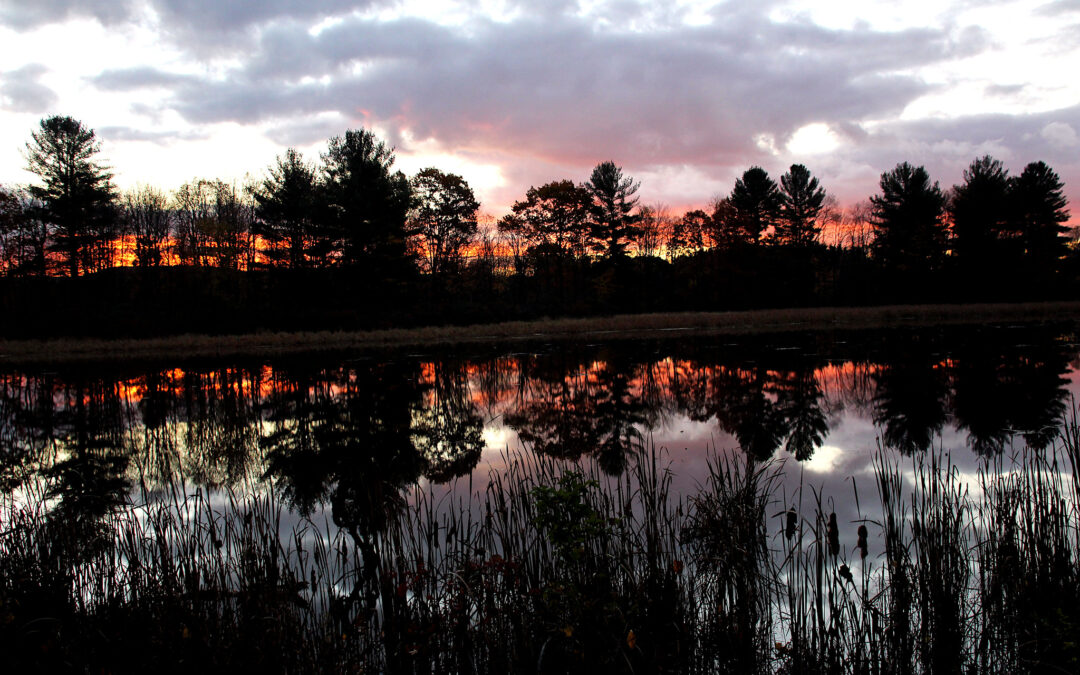By Emma Roth, Nature Educator
In mid-April, I took a trip to visit my old stomping grounds in the Poconos of eastern Pennsylvania. There, I met up with former coworkers-turned-friends for a weekend in the woods. The education center we used to work at, and where we spent this weekend, is a beautiful place. We stayed in cabins with trails leaving practically from our doorsteps.
When I worked there, I often took students on night hikes. These short excursions were about an hour long and covered less than a half mile, where we learned about nocturnal animals and their adaptations for living a life in the dark. We would also try some fun tricks you can do with your own night vision. I loved these night hikes. A trail that the students and I hiked mere hours before in the day was completely transformed in the night.
While on my weekend visit, I knew I had to go on a night hike. So, one evening well after the sun had set and the day’s socialization was done, I grabbed some water and a flashlight and hit the trail.
I don’t usually like to use a flashlight when I’m out on a night hike; I prefer to let my eyes adjust as I walk through the darkened forest. It always amazes me how well you can see after ten minutes in the dark woods. Even on a moonless night like this, I was easily able to stay on the trail, and, on the few occasions I started to veer off, the branches of underbrush and crunching of fresh leaves under my feet let me know I was going astray.
At night, especially on a dark one like this, you miss seeing the pieces of nature that dominate hikes during the day. Trees become amorphous shadows looming above you. Animals are either sleeping or stealthily moving away from you in the dark before you know they’re even there.
While the familiar forest disappears, a new forest is revealed. I could hear the calling of frogs from a nearby pond. There were the high-pitched spring peepers and their loud chorus. Pickerel frogs called, sounding like the creaking ropes of an old ship.
As I traveled down the trail the sound of the frogs disappeared, and a new sound emerged. I stopped in my tracks, worried as I heard the sound of small rain drops hitting the dry leaves on the ground. But looking up, the sky was clear. Curious of the source of the sound, I decided to sacrifice my night vision and turn on the flashlight. As soon as I did, the nearby rain-like sounds stopped. I bent down and shielded the light; the sounds started up. I carefully moved until I was right over whatever was making this sound and shined my light again.
Frozen in the beam was a spider. I looked around and realized they were everywhere. The sound of rain was actually thousands of small spiders, only a quarter of an inch across, moving over the leaves. I turned off my light again and listened to the march of the spiders.
After that discovery, I continued my walk down the trail relying more on touch to stay on track as my night vision slowly recovered. About 10 minutes later, faint lights appeared in front of me, glowing a yellow green. In the summer, it’s not uncommon to find bioluminescent mushrooms in the Poconos on a dark night. However, they wouldn’t appear until much later in the summer.
I bent down over one of the glowing objects. It was tiny and moving. Carefully, I felt in the grass and pulled out a small insect. It was the larva of a firefly. There were three others in the area, waiting until the time was just right to change into their adult form.
After about a mile and a half of hiking, I reached my goal. A rocky outcrop that, during the day, had a beautiful view down into the valley where the Delaware River chugged along. As I walked up to the edge of the outcrop this night, the view was different. A thick fog filled the valley. The mountains on the other side of the valley rose out of the fog as dark shadows.
I sat at the outcrop for only a few minutes. It was late, and I had another mile and a half to go to get back to my cabin. I retraced my steps back through the dark; past the glowing larvae on the ground, through the skittering of spider feet, until finally the calls of frogs returned, and the lights of buildings filtered through the trees.
Leaving the forest after a night hike is always somewhat jarring, but also comforting. When I’m in the dark woods, there’s always a lurking feeling that I don’t belong. This isn’t my world. I am just visiting a place that isn’t really meant for me. It’s a thrill to visit, and I love spending time in the alien-feeling space, but like any trip, it’s always nice to get back home.
Audubon Community Nature Center builds and nurtures connections between people and nature. ACNC is located just east of Route 62 between Warren and Jamestown. The trails are open from dawn to dusk and birds of prey can be viewed anytime the trails are open. The Nature Center is open from 10 a.m. until 4:30 p.m. daily except Sunday when it opens at 1 p.m. More information can be found online at auduboncnc.org or by calling (716) 569-2345.


Recent Comments